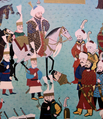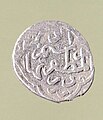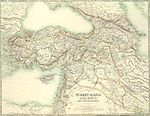Aq Qoyunlu
Aq Qoyunlu آق قویونلو | |||||||||||
|---|---|---|---|---|---|---|---|---|---|---|---|
| 1378–1503[a] | |||||||||||
A flag (sanjak) from the period of the Uzun Hasan's reign (the original here)
Bayandur used by the Aq Qoyunlu[2] | |||||||||||
 The Aq Qoyunlu confederation at its greatest extent under Uzun Hasan | |||||||||||
| Status | Confederate Sultanate | ||||||||||
| Capital |
| ||||||||||
| Common languages | |||||||||||
| Religion | Sunni Islam[8] | ||||||||||
| Government | Monarchy | ||||||||||
| Ruler | |||||||||||
• 1378–1435 | Qara Yuluk Uthman Beg | ||||||||||
• 1497–1503 | Sultan Murad | ||||||||||
| Legislature | |||||||||||
| Historical era | Medieval | ||||||||||
• First raid on the Trapezuntine Empire by Tur Ali Beg[9] | 1340 | ||||||||||
| 1348 | |||||||||||
• Established | 1378 | ||||||||||
• Coup by Uzun Hasan[3] | Autumn 1452 | ||||||||||
• Reunification[3] | 1457 | ||||||||||
| December, 1497 | |||||||||||
• Collapse of the Aq Qoyunlu rule in Iran[3] | Summer 1503 | ||||||||||
• End of the Aq Qoyunlu rule in Mesopotamia[3] | Autumn 1508 | ||||||||||
| Currency | Akçe[10] Ashrafi[10] Dinar[10] Tanka[10] Hasanbegî[11] (equal to 2 akçe) | ||||||||||
| |||||||||||
The Aq Qoyunlu or the White Sheep Turkomans
History
Etymology
The name Aq Qoyunlu, literally meaning "those with white sheep",[23] is first mentioned in late 14th century sources. It has been suggested that this name refers to old totemic symbols, but according to Rashid al-Din Hamadani, the Turks were forbidden to eat the flesh of their totem-animals, and so this is unlikely given the importance of mutton in the diet of pastoral nomads. Another hypothesis is that the name refers to the predominant color of their flocks.[3]
Origins
According to chronicles from the Byzantine Empire, the Aq Qoyunlu are first attested in the district of Bayburt south of the Pontic Mountains from at least the 1340s.[24] In these chronicles, Tur Ali Beg was mentioned as lord of the "Turks of Amid [Diyarbakir]", who had already attained the rank of
By the end of the
Uzun Hasan used to assert the claim that he was an "honorable descendant of
- Myth
The Aq Qoyunlu Sultans claimed descent from Bayindir Khan, who was a grandson of Oghuz Khan, the legendary ancestor of Oghuz Turks.[28]
According to Professor G. L. Lewis:[29]
The Ak-koyunlu Sultans claimed descent from Bayindir Khan and it is likely, on the face of it, that the Book of Dede Korkut was composed under their patronage. The snag about this is that in the Ak-koyunlu genealogy Bayindir's father is named as Gok ('Sky') Khan, son of the eponymous Oghuz Khan, whereas in our book he is named as Kam Ghan, a name otherwise unknown. In default of any better explanation, I therefore incline to the belief that the book was composed before Ak-koyunlu rulers had decided who their ancestors were. It was in 1403 that they ceased to be tribal chiefs and became Sultans, so we may assume that their official genealogy was formulated round about that date.
According to the Kitab-i Diyarbakriyya, the ancestors of Uzun Hasan back to the prophet Adam in the 68th generation are listed by name and information is given about them. Among them is Tur Ali Bey, the grandfather of Uzun Hasan's grandfather, who is also mentioned in other sources. But it is difficult to say whether Pehlivan Bey, Ezdi Bey and Idris Bey, who are listed in earlier periods, really existed. Most of the people who are listed as the ancestors of Uzun Hasan are names related to the Oghuz legend and to Oghuz rulers.[30]
Uzun Hasan
The Aq Qoyunlu Turkomans first acquired land in 1402, when
After the defeat of the Timurid leader, Abu Sa'id Mirza, Uzun Hasan was able to take Baghdad along with territories around the Persian Gulf. He expanded into Iran as far east as Khorasan. However, around this time, the Ottoman Empire sought to expand eastwards, a serious threat that forced the Aq Qoyunlu into an alliance with the Karamanids of central Anatolia.
As early as 1464, Uzun Hasan had requested military aid from one of the Ottoman Empire's strongest enemies, Venice. Despite Venetian promises, this aid never arrived and, as a result, Uzun Hassan was defeated by the Ottomans at the Battle of Otlukbeli in 1473,[33] though this did not destroy the Aq Qoyunlu.
In 1470, Uzun selected Abu Bakr Tihrani to compile a history of the Aq Qoyunlu confederation.[34] The Kitab-i Diyarbakriyya, as it was called, referred to Uzun Hasan as sahib-qiran and was the first historical work to assign this title to a non-Timurid ruler.[34]
Uzun Hasan preserved relationships with the members of the popular dervish order whose main inclinations were towards Shi'ism, while promoting the urban religious establishment with donations and confirmations of tax concessions or endowments, and ordering the pursuit of extremist Shiite and antinomist sects. He married one of his daughters to his nephew Haydar, the new head of the Safavid sect in Ardabil.[35]
Sultan Ya'qub

When Uzun Hasan died early in 1478, he was succeeded by his son
: 128Ya'qub, who reigned from 1478 to 1490, sustained the dynasty for a while longer. However, during the first four years of his reign there were seven pretenders to the throne who had to be put down.
Following Ya'qub's death, civil war again erupted, the Aq Qoyunlus destroyed themselves from within, and they ceased to be a threat to their neighbors. The
In his retreat from the Safavids, the Aq Qoyunlu leader Alwand destroyed an autonomous state of the Aq Qoyunlu in Mardin. The last Aq Qoyunlu leader, Sultan Murad, brother of Alwand, was also defeated by the same Safavid leader. Though Murād briefly established himself in Baghdad in 1501, he soon withdrew back to Diyar Bakr, signaling the end of the Aq Qoyunlu rule.
Ahmad Beg

Amidst the struggle for power between Uzun Hasan's grandsons Baysungur (son of Yaqub) and Rustam (son of Maqsud), their cousin Ahmed Bey appeared on the stage. Ahmed Bey was the son of Uzun Hasan's eldest son
Baysungur was dethroned in 1491 and expelled from Tabriz. He made several unsuccessful attempts to return before he was killed in 1493. Desiring to reconcile both his religious establishment and the famous Sufi order, Rustam (1478–1490) immediately allowed Sheikh Haydar Safavi's sons to return to Ardabil in 1492. Two years later, Ayba Sultan ordered their re-arrest, as their rise threatened the Ak Koyunlu again, but their youngest son, Ismail, then seven years old, fled and was hidden by supporters in Lahijan.[36][40]
According to Hasan Rumlu's Ahsan al-tavarikh, in 1496–97, Hasan Ali Tarkhani went to the Ottoman Empire to tell Sultan Bayezid II that Azerbaijan and Persian Iraq were defenceless and suggested that Ahmed Bey, heir to that kingdom, should be sent there with Ottoman troops. Bayezid agreed to this idea, and by May 1497 Ahmad Bey faced Rustam near Araxes and defeated him.[39]
After Ahmad's death, the Aq Qoyunlu became even more fragmented. The state was ruled by three sultans: Alvand Mirza in the west, Uzun Hasan's nephew Qasim in an enclave in Diyarbakir, and Alvand's brother Mohammad in Fars and Iraq-Ajam (killed by violence in the summer of 1500 and replaced by Morad Mirza). The collapse of the Aq Qoyunlu state in Iran began in the autumn of 1501 with the defeat at the hands of Ismail Safavi, who had left Lahijan two years earlier and gathered a large audience of Turkmen warriors. He conquered Iraq-Ajami, Fars and Kerman in the summer of 1503, Diyarbakir in 1507–1508 and Mesopotamia in the autumn of 1508. The last Aq Qoyunlu sultan, Morad, who hoped to regain the throne with the help of Ottoman troops, was defeated and killed by Ismail's Qizilbash warriors in the last fortress of Rohada, ending the political rule of the Aq Qoyunlu dynasty.[32][36]
Governance
The leaders of Aq Qoyunlu were from the Begundur or Bayandur clan of the
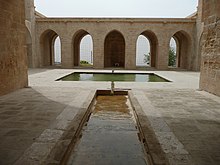
Uzun Hasan's conquest of most of mainland Iran shifted the seat of power to the east, where the Aq Qoyunlu adopted Iranian customs for administration and culture. In the Iranian areas, Uzun Hasan preserved the previous bureaucratic structure along with its secretaries, who belonged to families that had in a number of instances served under different dynasties for several generations.[3] The four top civil posts of the Aq Qoyunlu were all occupied by Iranians, which under Uzun Hasan included; the vizier, who led the great council (divan); the mostawfi al-mamalek, high-ranking financial accountants; the mohrdar, who affixed the state seal; and the marakur "stable master", who supervised the royal court.[3]
Culture flourished under the Aq Qoyunlu, who, although of coming from a Turkic background, sponsored Iranian culture. Uzun Hasan himself adopted it and ruled in the style of an Iranian king. Despite his Turkoman background, he was proud of being an Iranian.[44] At his new capital, Tabriz, he managed a refined Persian court. There he utilized the trappings of pre-Islamic Persian royalty and bureaucrats taken from several earlier Iranian regimes. Through the use of his increasing revenue, Uzun Hasan was able to buy the approval of the ulama (clergy) and the mainly Iranian urban elite, while also taking care of the impoverished rural inhabitants.[43]
In letters from the Ottoman Sultans, when addressing the kings of Aq Qoyunlu, such titles as
The Aq Qoyunlu realm was notable for being inhabited by many prominent figures, such as the poets Ali Qushji (died 1474), Baba Fighani Shirazi (died 1519), Ahli Shirazi (died 1535), the poet, scholar and Sufi Jami (died 1492) and the philosopher and theologian, Jalal al-Din Davani (died 1503).[44]
Culture
OIRATS
The Aq Qoyunlu patronized Persian belles-lettres which included poets like Ahli Shirazi, Kamāl al-Dīn Banāʾī Haravī, Bābā Fighānī, Shahīdī Qumī.[47] By the reign of Yaʿqūb, the Aq Qoyunlu court held a fondness for Persian poetry.[48] 16th-century Azerbaijani poet Fuzuli was also born and raised under Aq Qoyunlu rule, writing his first known poem for Shah Alvand Mirza.[49]
Nur al-Din 'Abd al-Rahman Jami dedicated his poem, Salāmān va Absāl, which was written in Persian, to Yaʿqūb.[50][51] Yaʿqūb rewarded Jami with a generous gift.[50] Jami also wrote a eulogy, Silsilat al-zahab, which indirectly criticised Yaʿqūb immoral behavior.[47] Yaʿqūb had Persian poems dedicated to him, including Ahli Shirazi's allegorical masnavi on love, Sham' va parvana and Bana'i's 5,000 verse narrative poem, Bahram va Bihruz.[47]
Yaʿqūb's maternal nephew, 'Abd Allah Hatifi, wrote poetry for the five years he spent at the Aq Qoyunlu court.[52]
Uzun Hasan and his son, Khalil,[53] patronized, along with other prominent Sufis, members of the Kobrāvi and Neʿmatallāhi tariqats.[54] According to the Tarikh-e lam-r-ye amini by Fazlallh b. Ruzbehn Khonji Esfahni, the court-commissioned history of Yaqub's reign, Uzun Hasan built close to 400 structures in the Aq Qoyunlu region for the purpose of Sufi communal retreat.[54]
Administration
The Aq Qoyunlu administration encompassed of two sections; the military caste, which mostly consisted of Turkomans, but also had Iranian tribesmen in it. The other section was the civil staff, which consisted of officials from established Persian families.[55]
Military structure
The organization of the Aq Qoyunlu army was based on the fusion of military traditions from both nomadic and settled cultures. The ethnic background of Aq-Qoyunlu troops were quite heterogeneous as it consisted of 'sarvars' of Azerbaijan, people of Persia and Iraq, Iranzamin askers, dilavers of Kurdistan, Turkmen mekhtars and others.[56][57]
| Padishah (Sovereign) | Head of Defence Ministry Tavachi dari | ||||||||||||||||||||||||||||||||||||||||||||||||||||||||||
| Head of Guards Qorchu bashi | Chief commander over army units (Amir al-Umara – Askeri qoshun) | Flag bearer (Emir alem) | Tavachi | Kadi nazir | Amir bitikchi | ||||||||||||||||||||||||||||||||||||||||||||||||||||||
| Royal bodyguard Boy nuker | Guards (qorchu) | Engineer corps | Chief Horseman (Emir Ahur) | ||||||||||||||||||||||||||||||||||||||||||||||||||||||||
| Garrisons | The superintendent of the hunt Amir-i Shikar | ||||||||||||||||||||||||||||||||||||||||||||||||||||||||||
| Artillery | Military inspector Ariz-i Lashkar | ||||||||||||||||||||||||||||||||||||||||||||||||||||||||||
| Road guards | Quartermaster Bukaul-i Lashkar | ||||||||||||||||||||||||||||||||||||||||||||||||||||||||||
| Regular army (Jeri) | Search units Balarguchi | ||||||||||||||||||||||||||||||||||||||||||||||||||||||||||
| Nomad units Mir-i el | Army Inspector Amiri Jandar | Jandar units | |||||||||||||||||||||||||||||||||||||||||||||||||||||||||
| Head of Food Supply Rikabdar | |||||||||||||||||||||||||||||||||||||||||||||||||||||||||||
| Head of Auxiliary troops Yasaul bashi | Yasaul units | ||||||||||||||||||||||||||||||||||||||||||||||||||||||||||
| Head of Camping Yurtchu bashi | Yurtchu units | ||||||||||||||||||||||||||||||||||||||||||||||||||||||||||
| Messenger Chavush | |||||||||||||||||||||||||||||||||||||||||||||||||||||||||||
| Jasus | |||||||||||||||||||||||||||||||||||||||||||||||||||||||||||
| Secret agents / spies Sahib Habar | |||||||||||||||||||||||||||||||||||||||||||||||||||||||||||
| Jagdiul | |||||||||||||||||||||||||||||||||||||||||||||||||||||||||||
| Head of Internal Affairs Eshik Agasi Bashi | |||||||||||||||||||||||||||||||||||||||||||||||||||||||||||
Gallery
-
A flag (sanjak) belonging to Aq Qoyunlu during Uzun Hassan's reign. (Topkapı Palace museum).
-
Zeynel Bey Mausoleum, formerly located in Hasankeyf.
-
Mehmed II and Ughurlu Muhammed (Hünername)
Coinage
-
Jahangir's coin, after 1444 AD.
-
Uzun Hasan's coin minted in Amid (Diyarbakir), c. 1453–1478 AD.
-
Sultan Yaqub's coin, c. 1479–1490 AD.
-
Baysunghur's coin minted in Tabriz, c. 1490–1493 AD.
-
Sultan Rustam's coin, 1495 AD.
-
Sultan Ahmad's coin minted in Tabriz, 1497 AD.
-
Coin of Sultan Muhammad.
-
Sultan Alwand's coin.
-
Sultan Murad's coin.
See also
| History of Azerbaijan | |
|---|---|
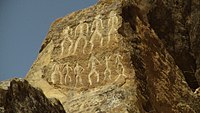 | |
| c.700 BC–c.590s BC | |
| Achaemenid Empire | 550 BC–330 BC |
| • Satrapy of Media | c.550 BC – 323 BC |
| Seleucid Empire | 312 BC – 63 BC |
| Parthian Empire | 247 BC – AD 224 |
| Caucasian Albania | c.200 BC – c.AD 800 |
| Roman Empire | 27 BC – AD 395 |


![Tamga of Bayandur used by the Aq Qoyunlu[2] of Aq Qoyunlu](http://upload.wikimedia.org/wikipedia/commons/thumb/3/3c/Tamga_of_Bayandur_%28Aq_Qoyunlu_version%29.svg/85px-Tamga_of_Bayandur_%28Aq_Qoyunlu_version%29.svg.png)



